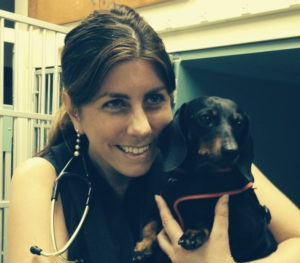[00:00:00] >> Dr. Brooke Britton: If we think of the bladder like a snow globe, and the tumor is the scene in the middle of the globe, and the water is the urine – and the snow in the globe are tumor cells.
[00:00:12] >> Announcer: Welcome to Dog Cancer Answers, where we help you help your dog with cancer.
[00:00:19] >> Molly Jacobson: Hello, friend. Today we’re taking a Listener Line call. Barbara has recently moved to Vermont and her Collie with bladder cancer has a new vet who is thinking he might be able to do a surgery. She’s wondering if that’s a possibility. To get more insight into this question, we’ve asked Dr. Brooke Britton to join us. Dr. Britton, thanks so much for joining us today.
[00:00:45] >> Dr. Brooke Britton: Thank you.
[00:00:46] >> Molly Jacobson: So our call today is from Barbara, and she is in Vermont and has a question about her dog with bladder cancer.
[00:00:56] >> Barbara: My name is Barbara and this doggy came out of Rocky Mountain Collie Sheltie Rescue, a fabulous organization run by Hope Hemperly who gave me this contact. My doggy is currently 13 years old and she was diagnosed a little over a year ago with bladder cancer.
I have had her to specialists and I am wanting to confirm, since I’ve moved, that the best treatment for the bladder cancer is a nonsteroidal anti-inflammatory piroxicam, and that is the regime we have had her on. I am currently living in Vermont, and one of the doctors here is considering a surgical option, which I don’t know at this point is the best answer for that situation. So, uh, that is my question. And she’s barking in the background, so I’m going to hang up.
[00:01:52] >> Molly Jacobson: That is a common occurrence here that we all have dogs barking in the background and we all are fine with it, right?
[00:01:57] >> Dr. Brooke Britton: Absolutely.
[00:01:59] >> Molly Jacobson: So Barbara has moved and a, sounds to me like a new veterinarian has an idea that they might be able to help her dog’s bladder cancer with surgery, that she’s been managing with NSAIDs so far.
What do you think?
[00:02:14] >> Dr. Brooke Britton: Yeah, so there’s a, there’s a lot to unpack in this question. Bladder cancers are most commonly carcinomas, which I’m assuming that this has likely been diagnosed or probably diagnosed as a carcinoma just given probability. There are other types of bladder cancers that we can see, but assuming that transitional cell carcinoma’s what we’re dealing with here, surgical options are definitely available, but most of the times we consider those only when the tumor has not yet spread or metastasized, and when it is located at what we call the apical aspect of the bladder. If you think of the bladder as a water balloon that’s filled and you have the curve of the bladder being the tip, and then you’ve got the neck of the bladder being kind of the neck of the balloon where you would blow it up.
[00:03:02] >> Molly Jacobson: Okay.
[00:03:02] >> Dr. Brooke Britton: Many bladder cancers actually are at the neck of the bladder, which is an area called the trigone. And so many important things insert into the trigone, all the plumbing. You know, the urethra that leads to the outside of the body, the ureters which lead up to the kidneys – and so this is why many oncologists and surgeons do not like to recommend surgery for most of the bladder TCCs, because they’re in the neck of the bladder and they’re much more difficult to remove, and really almost never removed in their entirety when they’re there because bladder tumors in dogs tend to be more invasive.
So if this tumor is smaller and it’s truly at the apex or the curve of the bladder, the curved tip, then surgery may be an option. It’s hard to know, again, without seeing kind of imaging of this bladder tumor. I imagine that the tumor has been monitored at least with ultrasound over time. If it was diagnosed a year ago and the dog is on piroxicam, which is an anti-inflammatory drug, that is actually, she’s correct, that’s the NSAID or nonsteroidal antiinflammatory of choice for bladder tumors where we can use it.
Some dogs are not as tolerant to piroxicam because it can cause a little bit more stomach upset. So if we see stomach upset, we do have other options. But many of the studies that have been done with NSAIDs and this tumor type were done with piroxicam so the data that we have is largely using that particular drug. There are definitely other options as well – chemotherapy, radiation – in addition to piroxicam and surgery.
One of the biggest concerns about surgery, in addition to not being able to get the entire tumor out, depending upon the location, is something called seeding of the tumor that can happen. So anytime we manipulate these tumors by poking them with needles or if we go in surgically and we manipulate them with gloves and instruments, even when we’re using the most sterile technique we can spread or seed the tumor because these cells shatter, exfoliate, very readily from the tumor surface.
And so even with a very careful surgeon who’s done this procedure a thousand times, implant seeding is still a possibility, and so it is a riskier surgery to do. The other thing that is important to know is that even if the tumor is entirely removed, the bulk of the tumor, many times these tumors just, in fact, almost invariably, these tumors grow back. And the reason is because of something called the field effect.
If we think of the bladder like a snow globe, and the tumor is the scene in the middle of the globe, and the water is the urine, and the snow in the globe are tumor cells, essentially you have these microscopic tumor cells that are floating around in the urine that have shed from the surface of the tumor.
And so even if we take the tumor out, if we just cut it out and it says we have a quote unquote "clean margin," the microscopic tumor cells that are floating in the urine will stick to surfaces on the inside of the bladder. And so like a snow globe, they’re floating all over and they can transplant the tumor further from the tumor site within the bladder.
So, typically, even with surgery, these tumors will come back. And that’s why they’re so difficult to treat in the longer term when they’re invasive and aggressive. If we can do surgery, again, that’s great, but it’s very careful patient selection for us and and few patients that actually can successfully receive a surgery and not have significant complication after.
[00:06:44] >> Molly Jacobson: That’s fascinating. We’re going to take a short break, but when we come back I wanna hear more about when tumor seeding can occur.
And we’re back with Dr. Brooke Britton. So this is specific to transitional cell carcinoma.
[00:07:01] >> Dr. Brooke Britton: Correct.
[00:07:02] >> Molly Jacobson: This seeding and this field effect does not necessarily happen with all tumor types, but we’re talking about TCC right now.
[00:07:09] >> Dr. Brooke Britton: Not necessarily with all tumor types. Carcinomas are the most common tumor that we associate seeding with.
[00:07:15] >> Molly Jacobson: Okay.
[00:07:15] >> Dr. Brooke Britton: Um, and the field effect is something that’s described in humans that we can kind of extrapolate to dogs specifically with regard to bladder tumors because we have this closed vessel and the urine floating all around in this vessel, um, and the tumor cells floating in that container, if you will.
[00:07:34] >> Molly Jacobson: Okay.
[00:07:34] >> Dr. Brooke Britton: So it’s a very specific example of seeding.
[00:07:37] >> Molly Jacobson: I see. So TCC is difficult to manage for lots of reasons. And the bottom line for Barbara is, where is that tumor located, how big is it, if it’s in the trigone region, that’s a really tough area to surgically remove anything from because it’s such a complex meeting place for so many different organs and there’s all sorts of nerves and all sorts of other things that can be damaged at the same time. So it’s a tricky surgery.
[00:08:05] >> Dr. Brooke Britton: Exactly.
[00:08:06] >> Molly Jacobson: But if it’s in an area on the wall, it might be a candidate, however, then you still have this problem where you might end up seeding the tumors and then there’s a recurrence that’s pretty likely with TCC because of the field effect. So it’s kind of a, those are all questions for her to really redirect to this veterinarian who’s thinking about surgery it sounds like.
[00:08:28] >> Dr. Brooke Britton: Absolutely. And it is a, because it’s a very high risk surgery in terms of seeding, again, it’s important to ideally have it performed by someone – if we’re going to do it – someone who’s done this procedure multiple times and is aware of those concerns so that their surgical technique is very specific.
Oftentimes, the surgeons who do this procedure will change their gloves and instrument packs multiple times throughout the procedure depending upon which part of the anatomy they’re handling at any given time to minimize the risk of seeding, if they’re going to do it.
[00:09:05] >> Molly Jacobson: So it’s a very, very specific – this is one of those cases where you wanna say, not just how many surgeries have you done, but how many of these surgeries have you done, it sounds like.
[00:09:14] >> Dr. Brooke Britton: Absolutely.
[00:09:15] >> Molly Jacobson: Okay. Well, thank you so much Dr. Britton.
[00:09:20] >> Dr. Brooke Britton: Thank you.
[00:09:23] >> Molly Jacobson: And thank you for calling, Barbara, with that really interesting question that got us into so many fascinating areas.
Bladder cancer is a rather disturbing – all cancers are disturbing, but bladder cancer, maybe just because I’m intimately familiar with that sense of having to pee really urgently and how uncomfortable that is, and it always strikes me as being a particularly uncomfortable state of being, bladder cancer. And, um, that snow globe, the idea that TCC, that carcinomas shed cells really quickly, that you need to do multiple changing of surgical instruments and gloves while doing that surgery… and the idea too, that, you know, different vets have different opinions.
This is just the way it is. Dr. Dressler once told me that if you ask two vets the same question, you’ll get three opinions. The practice of medicine is an art. There’s judgment calls in it. What’s right for one dog might not be right for another, or what’s right one month for one dog, a month later, may no longer be right to take on.
Well, thanks again, Barbara, for calling and, um, opening up this really interesting discussion. And I hope your Collie’s doing well at this point. And if you’ve got a question for us to bring to one of our veterinarian experts, please call us on our Listener Line at (808) 868-3200.
I’m Molly Jacobson. And for all of us here at Dog Podcast Network, I’m wishing you and your dog a warm, Aloha.
[00:11:02] >> Announcer: Thank you for listening to Dog Cancer Answers. If you’d like to connect, please visit our website at DogCancerAnswers.com or call our Listener Line at (808) 868-3200.
And here’s a friendly reminder that you probably already know: this podcast is provided for informational and educational purposes only. It’s not meant to take the place of the advice you receive from your dog’s veterinarian. Only veterinarians who examine your dog can give you veterinary advice or diagnose your dog’s medical condition. Your reliance on the information you hear on this podcast is solely at your own risk.
If your dog has a specific health problem, contact your veterinarian. Also, please keep in mind that veterinary information can change rapidly, therefore, some information may be out of date.
Dog Cancer Answers is a presentation of Maui Media in association with Dog Podcast Network.











